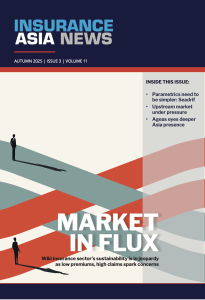SIRC: Asia’s cat modelling challenge is addressing the gap in knowledge: Guy Carpenter
November 3 2025 by Mithun Varkey
The majority of models used operationally in Asia Pacific do not account for the recent increasing frequency of extreme weather events, however, newer generation of cat models do have capability to produce alternative views which include loadings for climate scenarios, according to Mark Weatherhead, managing director and head of analytics for Southeast Asia and the Pacific at Guy Carpenter.
The models are based on a static “current climate state” view derived from analysis of historical data sets.
“When catastrophe models are built, typically, the hazard module is locked down first and then the model is calibrated. As such, there is a delay between when the hazard is set and the model is released,” said Weatherhead.
“In the past, this wasn’t a significant issue, and the models were considered fit for current near-climate modelling, but given the rate of change now observed, they fall out of date quickly.”
However, there is a balance to be found between stability of modelled losses and keeping models up to date, he said.
“The (re)insurance industry does not want or expect models to change dynamically every year to reflect the latest view on climate, as this would make it difficult to also understand and manage the effects of portfolio growth,” Weatherhead added.
Rather, the current expectation is that models will only be updated every three to five years.

“We need modelling of the baseline conditions to apply the adjustments, which can be difficult for Asia Pacific, where models don’t exist for all perils and countries.”
Mark Weatherhead, Guy Carpenter
However, Weatherhead noted that “there are still many demands on insurers to assess their climate risk for regulatory or strategic planning purposes”.
This is driven by local regulators requiring climate-risk assessments.
However, the challenges are that different regulators choose different scenarios, so there is not a single solution that can be applied everywhere.
“We need modelling of the baseline conditions to apply the adjustments, which can be difficult for Asia Pacific, where models don’t exist for all perils and countries,” he noted.
Guy Carpenter has developed flood models designed to allow for climate risk assessments for most countries, but there are still gaps for perils such as drought and impacts of excess heat and water shortage.
‘Secondary’ perils
While secondary perils is a misnomer, as they are driving significant loss, Weatherhead said: “The challenge in Asia is that these perils have by and large not been modelled, with the exception of Australia.”
The difficulty is that many insurance companies in the region have not yet developed internal expertise and/or technical tools to transform the raw scientific data into something that can be used for business decisions.
The challenge, according to Weatherhead, is how “we address the gap in knowledge”.
“This will change in time, but for now there is a reliance on experience-based loadings and external advice,” he added.
The newer generation of models from the larger commercial vendors, while very welcome, are still limited in their coverage and aim mostly at the larger, more established markets.
Plugging gaps
While Weatherhead does not see “too many problems with model credibility in the region, at least for the major countries and perils”, the bigger issue “is the quality of the data going into the models from the exposure side”.
“This is very mixed across the region. In some countries, detailed location-level data is the standard; in others, its data aggregated to province or even country level. However, we do see data improving every year,” he added.
Most insurance companies are working to improve their data, and there is a realisation that if they do not, they are at a disadvantage compared to their peers.
Location-level data allows for better representation of the splits between building and content values, and other secondary factors such as building height and construction.
“This can substantially change the modelling results and give a much-improved view of the risk,” he noted.
-
QBE | Elevating customer experience, humanising claims: QBE Asia’s ‘Solutions in a Box’
Vastly improving turnaround times and personalising service delivery, QBE Asia’s award-winning, end-to-end bundled claims solutions is a game-changer for the insurance industry.
-
Beazley | What does cyber protection look like from day 1 to day 600 and beyond?
Cybersecurity is no longer just an IT concern, but a governance issue that belongs on the boardroom agenda.
-
Sedgwick | Preparing for the next storm
Insurance industry needs to recalibrate, invest in innovation and strengthen systems, talent and data practices.
-
Peak Re | From climate modelling to market opportunity: Forging a new clarity on Southeast Asia’s climate risk
Southeast Asia's protection gap: a crisis of clarity, not just capital

